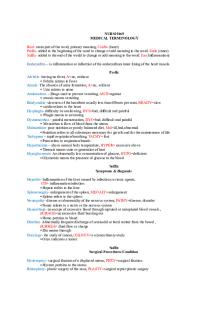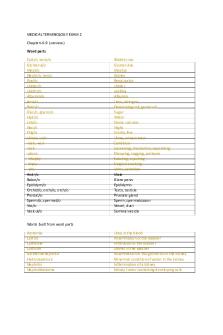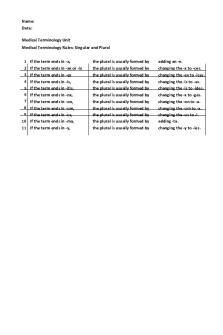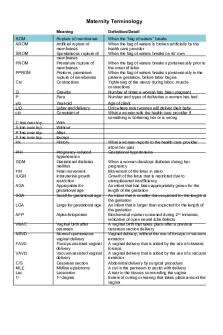420 Medical Terminology PDF

| Title | 420 Medical Terminology |
|---|---|
| Author | Syamily Mohan |
| Course | Bsc Nursing |
| Institution | Tamil Nadu Dr. M.G.R. Medical University |
| Pages | 143 |
| File Size | 3.2 MB |
| File Type | |
| Total Downloads | 10 |
| Total Views | 149 |
Summary
Medical Terminology It help for study purposes...
Description
Study Guide
Medical Terminology By Thea Liza Batan
About the Author Thea Liza Batan earned a Master of Science in Nursing Administration in 2007 from Xavier University in Cincinnati, Ohio. She has worked as a staff nurse, nurse instructor, and level department head. She currently works as a simulation coordinator and a freelance writer specializing in nursing and healthcare.
CONTENTS INSTRUCTIONS
1
READING ASSIGNMENTS
3
LESSON 1: THE FUNDAMENTALS OF MEDICAL TERMINOLOGY
5
LESSON 2: DIAGNOSIS, INTERVENTION, AND HUMAN BODY TERMS
28
LESSON 3: MUSCULOSKELETAL, CIRCULATORY, AND RESPIRATORY SYSTEM TERMS
44
LESSON 4: DIGESTIVE, URINARY, AND REPRODUCTIVE SYSTEM TERMS
69
LESSON 5: INTEGUMENTARY, NERVOUS, AND ENDOCRINE SYSTEM TERMS
96
SELF-CHECK ANSWERS
© PENN FOSTER, INC. 2017
134
MEDICAL TERMINOLOGY Contents
PAGE iii
INSTRUCTIONS INTRODUCTION Welcome to your course on medical terminology. You’re taking this course because you’re most likely interested in pursuing a health and science career, which entails p roficiencyincommunicatingwithhealthcareprofessionalssuchasphysicians,nurses, or dentists. As an aspiring member of a healthcare team, accurate understanding, pronunciation, spelling,anddefinitionoffrequentlyusedmedicaltermsisimperative.Thetextbookentitled Quick & Easy Medical Terminology, 8th Edition, by Peggy C. Leonard will provide basic knowledge and understanding of medical terminologies. Competence in using medical language doesn’t happen instantaneously. A strong medical vocabulary is a product of excellent time management skills and fervent commitment by the student.
COURSE OBJECTIVES When you complete this section, you’ll be able to do the following: Q Identify Q
word parts and write medical terms accurately
Q Utilizesuffixestobuildmedicalterminologiesrelatedtosurgicalprocedures,mediQ
cal conditions, specialists, and specialties Q Recognizeanduseprefixesinwritingmedicalterms Q Q Distinguish Q
and analyze medical terms associated with the digestive system
Q Identify Q
and be familiar with medical terminologies pertaining to the integumentary system
COURSE MATERIALS This course includes the following materials: 1. This study guide, which contains an introduction to your course, plus Q QA lesson
assignments page with a schedule of study assignments, as well as exams for the lessons you’ll complete during this course
Q QIndividual
sections that cover each of the main points of each lesson
Q QSelf-checks
and answers to help you assess your understanding of the
material 2. Your course textbook, Quick and Easy Medical Terminology, 8th Edition, which contains the assignment reading material
© PENN FOSTER, INC. 2017
MEDICAL TERMINOLOGY Instructions
PAGE 1
YOUR TEXTBOOK Your textbook, Quick and Easy Medical Terminology, 8th Edition, by Peggy C. Leonard contains the material on which you’ll be tested. You need to become familiar with this textbook before beginning your studies. You’ll want to begin by skimming the table of contents. This will give you an overview of the entire textbook. Read the preface as a brief introduction to the textbook. Appendices, found at the end of the text, provide medical abbreviations, word parts and their meanings, and answers to self-check questions. Following the appendices are a bibliography and photo credits, as well as an index.
STUDY PLAN Think of this study guide as a blueprint for your course. You should read it carefully. Using thefollowingproceduresshouldhelpyoureceivethemaximumbenefitfromyourstudies: Q Read Q
the lessons in the study guide to introduce you to concepts that are discussed in the textbook. The lessons emphasize the important material discussed in the text and provide additional tips or examples to help you grasp the material.
Q Note Q
the chapters for each assignment in the textbook and read the assignment in the textbook to get a general idea of its content. Study the assignment, paying attention to all details, especially the main concepts.
Q Answer Q
the questions and problems provided in the self-checks in the study guide. This will serve as a review of the material covered.
Q After Q
answering the suggested questions, check your answers with those given in the back of the study guide. If you miss any questions, review the pages of the textbook covering those questions. The self-checks are designed to reveal weak points that you need to review. Do not send the self-check answers to the school. They’re for you to evaluate your understanding of the material. Complete each assignment in this way.
Q After Q
you’ve completed and checked the self-checks for Lesson 1, go to your studentportalandcompleteyourfirstexam.
Q Follow Q
this procedure for all lessons. At any time, you can contact your instructor for information regarding the materials.
Remember to check your student portal regularly. Additional resources to enhance your learning experience may be posted.
© PENN FOSTER, INC. 2017
MEDICAL TERMINOLOGY Instructions
PAGE 2
READING ASSIGNMENTS Lesson 1: The Fundamentals of Medical Terminology Read in the study guide:
Read in the textbook:
Section 1.1
Chapter 1
Section 1.2
Chapter 2
Section 1.3
Chapter 3
Examination 427782RR
Lesson 2: Diagnosis, Intervention, and Human Body Terms Read in the study guide:
Read in the textbook:
Section 2.1
Chapter 4
Section 2.2
Chapter 5
Examination 427783RR
Lesson 3: Musculoskeletal, Circulatory, and Respiratory System Terms Read in the study guide:
Read in the textbook:
Section 3.1
Chapter 6
Section 3.2
Chapter 7
Section 3.3
Chapter 8
Examination 427784RR
Lesson 4: Digestive, Urinary, and Reproductive System Terms Read in the study guide:
Read in the textbook:
Section 4.1
Chapter 9
Section 4.2
Chapter 10
Section 4.3
Chapter 11
Examination 427785RR
© PENN FOSTER, INC. 2017
MEDICAL TERMINOLOGY Reading Assignments
PAGE 3
Lesson 5: Integumentary, Nervous, and Endocrine System Terms Read in the study guide:
Read in the textbook:
Section 5.1
Chapter 12
Section 5.2
Chapter 13
Section 5.3
Chapter 14
Section 5.4
Chapter 15
Examination 427786RR
Note: To access and complete any of the examinations for this study guide, click the appropriate Take Exam icon on your student portal. You shouldn’t have to enter the examination numbers. These numbers are for reference only if you have reason to contact Student Services.
© PENN FOSTER, INC. 2017
MEDICAL TERMINOLOGY Reading Assignments
PAGE 4
LESSON 1: THE FUNDAMENTALS OF MEDICAL TERMINOLOGY INTRODUCTION Foralayperson,learningmedicallanguagemayseemdifficult,butitbecomeseasieras one gets to know the origin and meaning of medical terms. For healthcare professionals, it’s already second nature. The majority of the medical terms are borrowed from Latin and Greek, but it’s unnecessary for you to learn these languages to become experts in the use of and understanding of medical terms. All you need to do is to study and learn word parts.
SECTION 1.1: SIMPLIFIED MEDICAL LANGUAGE Read the following section, then read Chapter 1 in your textbook. Objectives When you complete this section, you’ll be able to identify word parts and write medical terms properly.
SIMPLIFIED MEDICAL LANGUAGE The building block for most medical terms is the word root, or the primary body of a word. At times, a medical term can be made up of compound words. A compound word may consist of two word roots, such as in the case of collarbone (collar + bone). To facilitate the pronunciation of words, a combining vowel is placed in between word roots.Asignificantnumberofmedicaltermsusethevowel“o”.However,it’sgoodtonote that“o”isn’ttheonlyvowel.
© PENN FOSTER, INC. 2017
MEDICAL TERMINOLOGY Lesson 1
PAGE 5
The following table demonstrates examples of roots and combining forms.
Word Root
Combining Vowel
Combining Form
Meaning
Use in a Word
acr
+
o
acr/o
extremity
acrocyanosis
psych
+
o
psych/o
mind
psychology
chol
+
e
chol/e
bile
cholesterase
PREFIXES AND SUFFIXES Prefixesandsuffixesmayaccompanyawordroottoalteritsmeaning.Aprefix is attached before the word, while a suffix is placed at the end of a word root. Sometimes, a wordmayconsistofaprefixandasuffixonly. Prefix + Combining form + Suffix electro + cardi/o + gram (electrocardiogram) Prefix + Suffix hyper + emia (hyperemia)
Bynow,you’vealreadylearnedwordparts.Wordroots,combiningforms,prefixes,and suffixesareallwordparts.
WRITING MEDICAL TERMS Building words follows certain guidelines. Table 2 presents some common rules in word building. Guidelines
Examples
Linking combining forms
In most instances, the combining vowel is retained amid combining forms.
leuk/o + cyte
leukocyte
cardi/o + logy
cardiology
Linking combining formsandsuffixes
Use a combining vowel ifthesuffixbeginswitha consonant.
crani/o + tomy
craniotomy
derm/a + tology
dermatology
Linking combining formsandsuffixes with initial vowels
Omit the combining vowel ifthesuffixbeginswitha vowel.
appendic/o + itis
appendicitis
enter/o + ic
enteric
Linking other word partsandprefixes
Usually,prefixesneednotbe changed when linked with other word parts.
dys + pepsia
dyspepsia
intra +dermal
intradermal
© PENN FOSTER, INC. 2017
MEDICAL TERMINOLOGY Lesson 1
PAGE 6
To better recognize the parts that make up a medical term, word division is commonly used throughout this course. For instance, appendectomy may be written as append + ectomy to highlight its component parts.
EPONYMS Eponyms are names derived from a proper noun. They may originate from the name ofaperson,place,orthing.Inthemedicalfield,diseases,organs,procedures,or body functions can be eponyms; hence, they are frequently capitalized. Examples of eponyms include Alzheimer’s disease, after Alois Alzheimer, and Babinski sign, after Joseph Babinski.
ABBREVIATIONS AND PHARMACOLOGY An abbreviation is a shortened form of a word or phrase. Abbreviations can be in the form of: Q Letters: Q
The abbreviation for chest x-ray is CXR.
Q Shortenedwords:Theabbreviation“tab”isshortfor“tablet.” Q Q Acronyms: Q
The acronym CPR stands for cardiopulmonary resuscitation.
Note: Abbreviations and symbols should be used cautiously, especially when medications are involved. The Institute for Safe Medication Practices (ISMP) and The Joint Commission (TJC) provide a list of unsafe abbreviations and symbols.
The branch of science that deals with the preparation, properties, uses, and actions of drugs is known as pharmacology. Drugs, most commonly referred to as medicines, are used in the prevention and treatment of diseases. Concepts related to drugs include the following: Q Route Q
of administration: ways in which drugs can be given (usually via the mouth or via an injection)
Q Generic Q
name: nonproprietary name of the drug (for example, ibuprofen)
Q Trade Q
name: company name, otherwise known as the brand name (for example, Motrin)
© PENN FOSTER, INC. 2017
MEDICAL TERMINOLOGY Lesson 1
PAGE 7
PLURALS The plural form of many medical terms follows the rules used in common language. Word endings
Singular form
Plural Form
contusion
contusions
Consonants other than s, h, or y s, ch, sh y
virus
viruses
allergy
allergies
General Guidelines in Forming Plurals of Nouns with Special Endings Singular Ending
Plural Ending
is
Examples (Singular)
es
Examples (Plural)
diagnosis, anastomosis
diagnoses, anastomoses
*Some words ending in is take on their plural form by omitting the is and adding ides, as in arthritis and arthritides um
a
atrium, ostium
atria, ostia
us
i
bronchus, alveolus
bronchi, alveoli
*Some words ending in us take on their plural form by omitting the us and adding era or ora, as in viscus to viscera and corpus to corpora. a
ae
cava, vertebra
cavae, vertebrae
ix
ices
appendix, cervix
appendices, cervices
ex
ices
apex
apices
ax
aces
thorax
thoraces
ma
s or mata
condyloma
condylomas or condylomata
on
a
spermatozoon
spermatozoa
*Some words ending in on take on their plural form by adding s, as in chorion to chorions nx
nges
phalanx
phalanges
After you’ve carefully read Chapter 1 in your textbook, complete Self-Check 1.1. When you completely understand the material from Section 1.1, move on to Section 1.2.
© PENN FOSTER, INC. 2017
MEDICAL TERMINOLOGY Lesson 1
PAGE 8
Self-Check 1.1 At the end of each section of Quick and Easy Medical Terminology, 8th Edition, you’ll be asked to pause and check your understanding of what you’ve just read by completing a self-check. Writing the answers to these questions will help you review what you have learned so far. Please complete Self-Check 1.1 now.
Complete Practice Exercises A–H at the end of Chapter 1 of your textbook.
Check your answers with those in Appendix III of your textbook.
SECTION 1.2: SUFFIXES AND COMBINING FORMS MADE EASY Read the following section, then read Chapter 2 in your textbook.
Objective Whenyoucompletethissection,you’llbeabletoutilizesuffixestobuildmedical terminologies related to surgical procedures, medical conditions, specialists, and specialties.
MEDICAL SPECIALISTS AND THEIR SPECIALTIES Identifying medical specialists and their specialties is made easy by recognizing the meaningsofthesuffixesattachedtothewordroot.Forexample,thesuffix-logy refers to the“studyorscienceof.”Anesthesiologyisthebranchofmedicalsciencethatspecifically
© PENN FOSTER, INC. 2017
MEDICAL TERMINOLOGY Lesson 1
PAGE 9
dealswiththestudyofanesthesiaoranesthetics.Ontheotherhand,thesuffix-logist means“onewhostudies”or“specialist.”Ananesthesiologist is a physician who specializes in anesthesia. It’s important not to confuse anesthesiologist with anesthetist. The suffix-istmeans“onewho”;hence,ananesthetist is one who administers anesthesia. An anesthetist can be a physician or a nurse, while an anesthesiologist is a medical doctor orphysician.Studythefollowingsuffixesandtheirmeanings. SUFFIXES: MEDICAL SPECIALISTS AND THEIR SPECIALTIES Medical Specialists Suffix
Meaning
Medical Specialties Example
Suffix
Meaning
Example
-er, -ist
one who
internist
-ac, -al, -ic, ical
pertaining to
obstetrical
-iatrician
practitioner
pediatrician
-logic, -logical
pertaining to the study of
psychological
-logist
one who studies, specialist
pulmonologist
-iatrics, -iatry
medical profession or treatment
pediatrics
-logy
study or science of
gynecology
The following table lists some of the most common combining forms associated with medical specialties and specialists. Combining Form
Meaning
Medical Specialty cardiology
Medical Specialist
cardi/o
heart
cardiologist
dermat/o
skin
dermatology
dermatologist
esthesi/o
feeling or sensation
anesthesiology
anesthesiologist
gynec/o
female
gynecology
gynecologist
immune/o
immune
immunology
immunologist
ne/o, nat/o
new, birth
neonatology
neonatologist
ophthalm/o
eye
ophthalmology
ophthalmologist
path/o
disease
pathology
pathologist
radi/o
radiation or radius
radiology
radiologist
ur/o
urinary tract or urine
urology
urologist
SURGICAL PROCEDURES Asignificantnumberofmedicaltermsrefertosurgicalprocedures.Generally,thesuffixesusedwillgiveyouanideaaboutthetypeofsurgeryorprocedureperformed.For instance,thesuffix-ectomy means surgical removal. Polypectomy and adrenalectomy refer to the excision or removal of polyps and adrenal glands, respectively. Knowing a familiarwordrelatedtothesuffixmakesiteasiertoanalyzeamedicalterm.Thisprocess is known as word association. Take a look at the following table.
© PENN FOSTER, INC. 2017
MEDICAL TERMINOLOGY Lesson 1
PAGE 10
SUFFIXES: SURGICAL PROCEDURES Suffix
Meaning
Word Association
-centesis
surgical puncture to aspirate or removefluid
Paracentesis is a puncture of the peritonealcavitytoremovefluidfordiagnostic or therapeutic purposes.
-ectomy
excision (surgical removal or cutting out)
Excision of the appendix is referred to as an appendectomy.
-lysis
process of loosening, freeing, or destroying
Thissuffixcanalsomeandissolvingor destruction, as in hydrolysis.
-pe...
Similar Free PDFs

420 Medical Terminology
- 143 Pages

Medical Terminology
- 50 Pages

Medical Terminology
- 6 Pages

Medical Terminology
- 2 Pages

Medical Terminology
- 4 Pages

Medical Terminology EXAM 2
- 4 Pages

Medical terminology Modules
- 158 Pages

Medical Terminology Terms
- 22 Pages

Medical Terminology-Plurals Quiz
- 3 Pages

Medical terminology 17
- 4 Pages

Med term - medical terminology
- 20 Pages

Medical Terminology Final Exam
- 5 Pages

Medical terminology 2
- 3 Pages

Medical terminology 22
- 2 Pages

Medical Terminology 2018
- 3 Pages
Popular Institutions
- Tinajero National High School - Annex
- Politeknik Caltex Riau
- Yokohama City University
- SGT University
- University of Al-Qadisiyah
- Divine Word College of Vigan
- Techniek College Rotterdam
- Universidade de Santiago
- Universiti Teknologi MARA Cawangan Johor Kampus Pasir Gudang
- Poltekkes Kemenkes Yogyakarta
- Baguio City National High School
- Colegio san marcos
- preparatoria uno
- Centro de Bachillerato Tecnológico Industrial y de Servicios No. 107
- Dalian Maritime University
- Quang Trung Secondary School
- Colegio Tecnológico en Informática
- Corporación Regional de Educación Superior
- Grupo CEDVA
- Dar Al Uloom University
- Centro de Estudios Preuniversitarios de la Universidad Nacional de Ingeniería
- 上智大学
- Aakash International School, Nuna Majara
- San Felipe Neri Catholic School
- Kang Chiao International School - New Taipei City
- Misamis Occidental National High School
- Institución Educativa Escuela Normal Juan Ladrilleros
- Kolehiyo ng Pantukan
- Batanes State College
- Instituto Continental
- Sekolah Menengah Kejuruan Kesehatan Kaltara (Tarakan)
- Colegio de La Inmaculada Concepcion - Cebu
